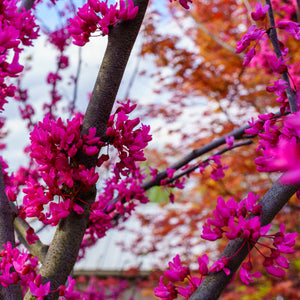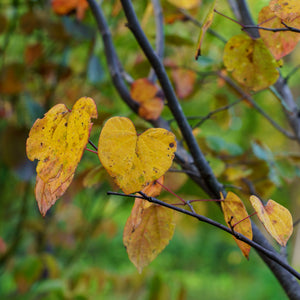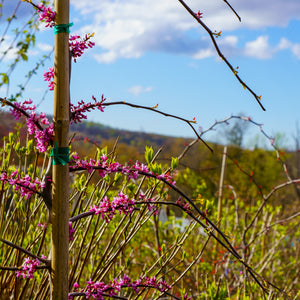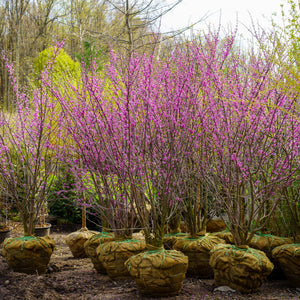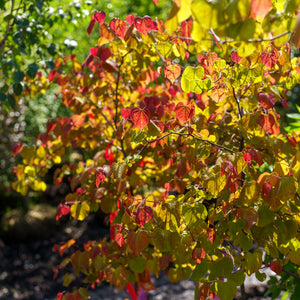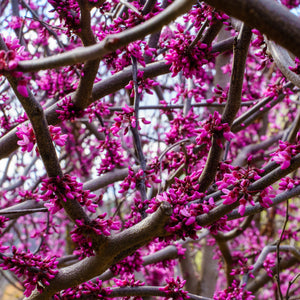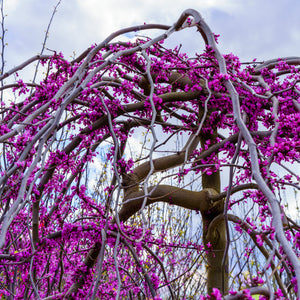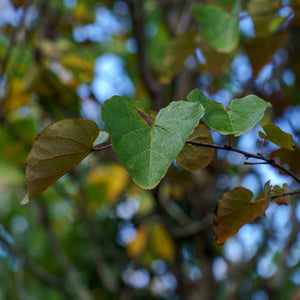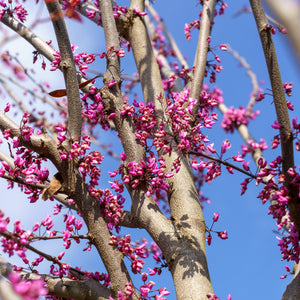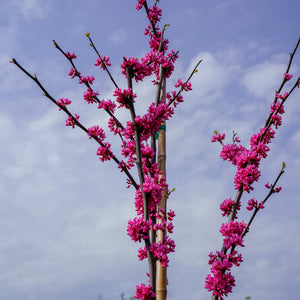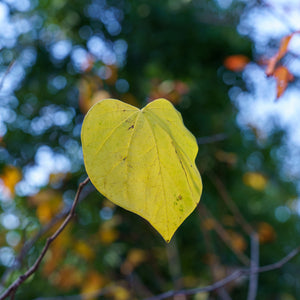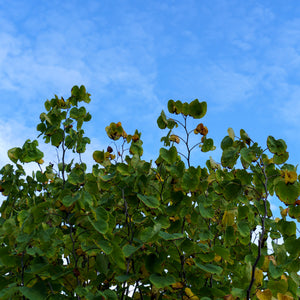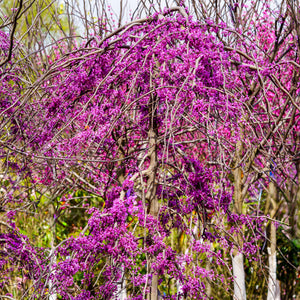The Redbud Guide
Redbuds, scientifically known as Cercis, are enchanting deciduous trees that can bring both beauty and functionality to your landscape. With their distinctive form, clusters of vibrant pink or purple blossoms, and heart-shaped leaves, redbuds are a versatile and valuable addition to your garden and outdoor spaces. They grace your landscape with delightful spring blooms, attract pollinators, and provide aesthetic value. Whether you plant them as ornamental trees, incorporate them into mixed borders, or aim to enhance local ecosystems, redbuds offer year-round appeal and environmental benefits. With proper planting and care, you can ensure that redbuds flourish, adding a touch of nature and charm to your outdoor environment.
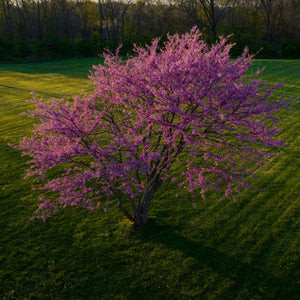
About
Redbuds, members of the Fabaceae family, form a diverse genus of deciduous trees appreciated for their captivating presence and ecological importance. This remarkable group encompasses several well-recognized species spread across North America and other temperate regions.
Redbuds are known for their graceful form and clusters of striking pink or purple blossoms that grace their branches. They create a spectacular display, particularly during the spring. As the growing season unfolds, redbuds' foliage transforms into vibrant shades of green, contributing to their year-round allure.
Their role in local ecosystems is significant, as redbud trees provide sustenance and shelter for various wildlife species. Their blossoms, abundant in nectar, draw in pollinators, while their seeds serve as a valuable food source for birds and other animals.
Redbuds are adaptable to diverse soil types and environmental conditions, and their moderate growth rate makes them a preferred choice for both ornamental landscaping and ecological restoration.
Whether you plant them as ornamental trees, create wildlife-friendly habitats, or incorporate them into mixed plantings, redbuds' beauty and ecological contributions make them a stellar addition to any outdoor environment.
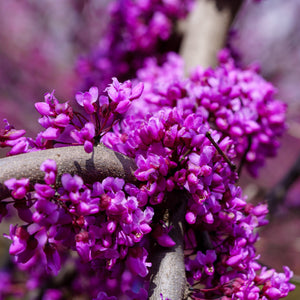
Planting
Redbuds have specific planting requirements to ensure their successful establishment and growth. Here are some general guidelines for planting and caring for redbuds:
Soil: Redbuds thrive in well-drained soil that is rich in organic matter. They typically prefer slightly acidic soil with a pH between 5.0 and 6.5. Before planting, prepare the site by loosening the soil and incorporating compost or organic matter to enhance drainage and soil fertility.
Sunlight: Redbuds prefer full sun to partial shade. Choose a location that receives at least six hours of direct sunlight each day for optimal growth. While they can tolerate partial shade, providing more sunlight generally results in better flowering and overall health.
Watering: Adequate watering is crucial, especially during the initial establishment of redbuds. Water deeply right after planting and continue to provide regular irrigation throughout the first year. Water deeply and thoroughly once or twice a week, adjusting the frequency based on rainfall and soil moisture levels. Ensure the soil remains consistently moist but not waterlogged, as overly wet conditions can lead to root rot.
Mulching: Apply a layer of organic mulch, such as wood chips, bark, or compost, around the base of your redbud. Mulch serves to conserve moisture, suppress weed growth, and regulate soil temperature. However, it's essential to keep the mulch a few inches away from the trunk to prevent excess moisture buildup and potential trunk rot.
Pruning: Redbuds generally require minimal pruning. Remove any dead, damaged, or crossing branches to maintain a strong and balanced structure. Prune during late winter or early spring while the tree is still dormant, before new growth emerges.
By following these basic planting and care guidelines, you can ensure the successful establishment and healthy growth of your redbuds, allowing them to thrive and bring beauty to your landscape for years to come.
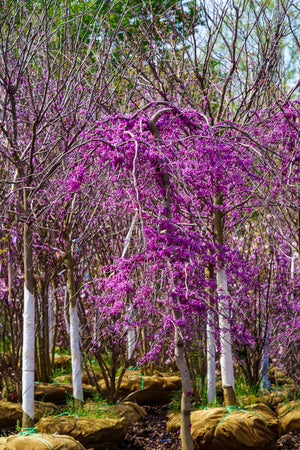
Care
Redbuds require specific care to ensure their optimal growth and health. Here are some general guidelines for the care of redbuds:
Watering: During the growing season, provide moderate watering to your redbuds. Aim for about one inch of water per week, adjusting as needed based on rainfall. It's important to water deeply and thoroughly to encourage deep root growth. Shallow watering can lead to surface root development and potential stress, especially during periods of drought or high temperatures. Be prepared to provide additional watering when necessary to maintain consistently moist soil.
Pruning: Redbuds typically do not require extensive pruning. However, it's advisable to remove any dead, damaged, or crossing branches to maintain the tree's overall health and appearance. You may also shape the tree to achieve the desired size and form. Prune during late winter or early spring while the tree is still dormant and before new growth emerges. Use clean, sharp pruning tools to minimize the risk of damaging the tree. Deadheading spent flowers can also encourage new growth and potentially trigger a second blossoming.
Fertilizing: Fertilizing can promote healthy growth and flowering in redbuds. Apply a balanced, slow-release fertilizer in the spring or early summer, following the recommended application rates and timing provided by the manufacturer. Avoid over-fertilizing, as it can harm the tree's roots. When in doubt, use less fertilizer to prevent overfeeding.
Soil and Sunlight: Redbuds prefer well-drained, moist soil and thrive in full sun exposure. While they are relatively adaptable to different soil types, providing well-draining soil is essential for their optimal growth. Additionally, mulching around the base of the tree helps retain moisture and regulate soil temperature.
Pests and Diseases: Redbuds are generally resistant to pests and diseases. However, it's essential to monitor for common issues such as aphids, canker diseases, or verticillium wilt. If you observe any signs of damage or disease, promptly treat the tree with appropriate insecticides or fungicides to prevent further issues.
By following these basic care guidelines, your redbuds will thrive, providing beauty, seasonal interest, and an appealing presence in your garden for years to come.
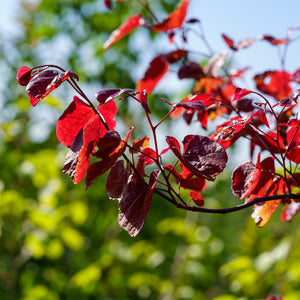
How To Use
Redbuds offer versatility and can be used in various ways to enhance your landscape. Here are some recommendations based on their characteristics:
Focal Point: Redbuds possess a remarkable presence, making them an ideal choice as a focal point in your landscape. Plant a single redbud tree in an open area to showcase its elegant form and captivating blossoms. Alternatively, create a stunning visual impact by planting a cluster of redbuds together.
Shade Provider: With their spreading canopies and abundant foliage, redbuds provide excellent shade. Plant them strategically near outdoor seating areas, patios, or decks to create a cool and comfortable space where you can relax and enjoy the outdoors during hot summer days.
Windbreak: Redbuds, with their sturdy growth and arching branches, can serve as an effective windbreak. Plant them in a row to shield your garden or home from strong winds, providing a natural barrier and protection for your outdoor spaces.
Privacy Screen: Utilize the lush foliage of redbuds to create a natural privacy screen in your landscape. Plant them in a row along your property line to establish an attractive and functional barrier that enhances both privacy and aesthetics.
Wildlife Habitat: Redbuds contribute to the overall biodiversity of your garden by attracting various wildlife species. Birds and other animals are drawn to the blossoms, which serve as a valuable source of nectar, and the shelter provided by redbuds. Create a welcoming habitat by planting redbuds and enjoy the sights and sounds of wildlife thriving in your outdoor space.
When selecting redbuds for your landscape, consider their growth rate and environmental requirements. Ensure they are planted in areas that receive full sun or partial shade and provide well-drained soil. With their graceful form, captivating blossoms, and functional benefits, redbuds are an exceptional addition that will enhance the beauty and functionality of your outdoor environment.
Conclusion
Redbuds are a captivating and versatile addition to any landscape. Their remarkable presence, distinctive blossoms, and ecological significance make them a highly desirable choice for various outdoor settings. By adhering to proper planting and care practices, you can enjoy the beauty and benefits of redbuds in numerous ways, whether it's creating a picturesque garden pathway or providing a serene retreat in your backyard. Whether you choose to showcase their elegance as a focal point or incorporate them into a larger landscape design, redbuds offer endless possibilities to enhance the allure of your outdoor space. With dedication and care, you can create a breathtaking landscape that will bring you lasting joy for years to come.

